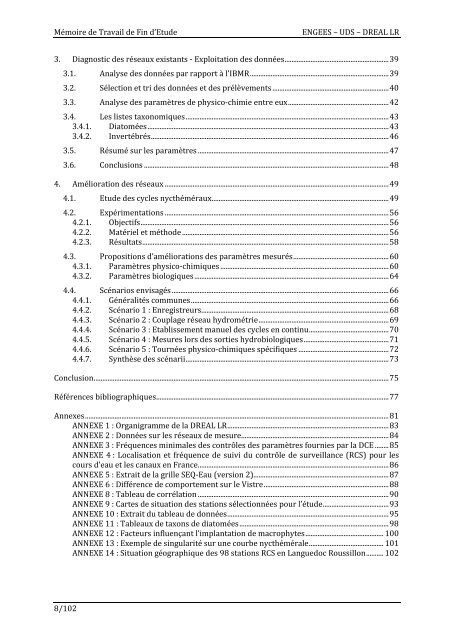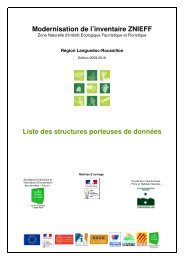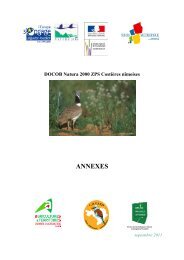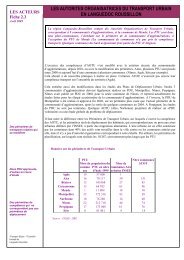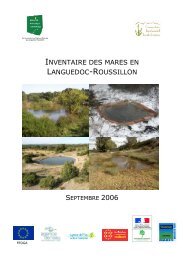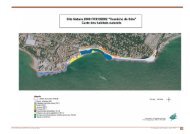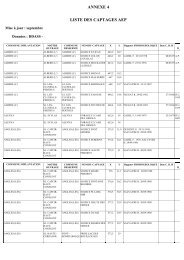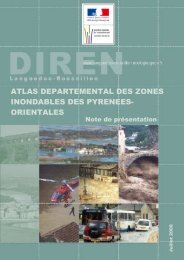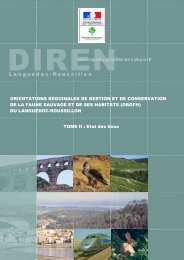Rapport de stage - DREAL Languedoc-Roussillon
Rapport de stage - DREAL Languedoc-Roussillon
Rapport de stage - DREAL Languedoc-Roussillon
You also want an ePaper? Increase the reach of your titles
YUMPU automatically turns print PDFs into web optimized ePapers that Google loves.
Mémoire <strong>de</strong> Travail <strong>de</strong> Fin d’Etu<strong>de</strong> ENGEES – UDS – <strong>DREAL</strong> LR<br />
3. Diagnostic <strong>de</strong>s réseaux existants - Exploitation <strong>de</strong>s données ............................................................ 39<br />
3.1. Analyse <strong>de</strong>s données par rapport { l’IBMR ................................................................................ 39<br />
3.2. Sélection et tri <strong>de</strong>s données et <strong>de</strong>s prélèvements ................................................................... 40<br />
3.3. Analyse <strong>de</strong>s paramètres <strong>de</strong> physico-chimie entre eux .......................................................... 42<br />
3.4. Les listes taxonomiques ..................................................................................................................... 43<br />
3.4.1. Diatomées ........................................................................................................................................... 43<br />
3.4.2. Invertébrés ......................................................................................................................................... 46<br />
3.5. Résumé sur les paramètres .............................................................................................................. 47<br />
3.6. Conclusions ............................................................................................................................................. 48<br />
4. Amélioration <strong>de</strong>s réseaux ................................................................................................................................. 49<br />
4.1. Etu<strong>de</strong> <strong>de</strong>s cycles nycthéméraux ...................................................................................................... 49<br />
4.2. Expérimentations ................................................................................................................................. 56<br />
4.2.1. Objectifs ............................................................................................................................................... 56<br />
4.2.2. Matériel et métho<strong>de</strong> ....................................................................................................................... 56<br />
4.2.3. Résultats .............................................................................................................................................. 58<br />
4.3. Propositions d’améliorations <strong>de</strong>s paramètres mesurés ....................................................... 60<br />
4.3.1. Paramètres physico-chimiques ................................................................................................. 60<br />
4.3.2. Paramètres biologiques ................................................................................................................ 64<br />
4.4. Scénarios envisagés ............................................................................................................................. 66<br />
4.4.1. Généralités communes .................................................................................................................. 66<br />
4.4.2. Scénario 1 : Enregistreurs ............................................................................................................ 68<br />
4.4.3. Scénario 2 : Couplage réseau hydrométrie ........................................................................... 69<br />
4.4.4. Scénario 3 : Etablissement manuel <strong>de</strong>s cycles en continu .............................................. 70<br />
4.4.5. Scénario 4 : Mesures lors <strong>de</strong>s sorties hydrobiologiques ................................................. 71<br />
4.4.6. Scénario 5 : Tournées physico-chimiques spécifiques .................................................... 72<br />
4.4.7. Synthèse <strong>de</strong>s scénarii ..................................................................................................................... 73<br />
Conclusion .......................................................................................................................................................................... 75<br />
Références bibliographiques ...................................................................................................................................... 77<br />
Annexes ............................................................................................................................................................................... 81<br />
ANNEXE 1 : Organigramme <strong>de</strong> la <strong>DREAL</strong> LR ............................................................................................. 83<br />
ANNEXE 2 : Données sur les réseaux <strong>de</strong> mesure ..................................................................................... 84<br />
ANNEXE 3 : Fréquences minimales <strong>de</strong>s contrôles <strong>de</strong>s paramètres fournies par la DCE ........ 85<br />
ANNEXE 4 : Localisation et fréquence <strong>de</strong> suivi du contrôle <strong>de</strong> surveillance (RCS) pour les<br />
cours d’eau et les canaux en France .............................................................................................................. 86<br />
ANNEXE 5 : Extrait <strong>de</strong> la grille SEQ-Eau (version 2).............................................................................. 87<br />
ANNEXE 6 : Différence <strong>de</strong> comportement sur le Vistre ........................................................................ 88<br />
ANNEXE 8 : Tableau <strong>de</strong> corrélation .............................................................................................................. 90<br />
ANNEXE 9 : Cartes <strong>de</strong> situation <strong>de</strong>s stations sélectionnées pour l’étu<strong>de</strong> ...................................... 93<br />
ANNEXE 10 : Extrait du tableau <strong>de</strong> données ............................................................................................. 95<br />
ANNEXE 11 : Tableaux <strong>de</strong> taxons <strong>de</strong> diatomées ...................................................................................... 98<br />
ANNEXE 12 : Facteurs influençant l’implantation <strong>de</strong> macrophytes ............................................. 100<br />
ANNEXE 13 : Exemple <strong>de</strong> singularité sur une courbe nycthémérale ........................................... 101<br />
ANNEXE 14 : Situation géographique <strong>de</strong>s 98 stations RCS en <strong>Languedoc</strong> <strong>Roussillon</strong> .......... 102<br />
8/102


